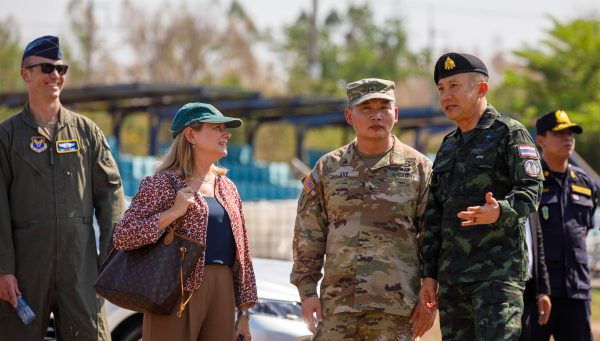By Christopher Woody
Copyright thediplomat

Thailand’s scramble to evacuate its citizens from Israel after Hamas’ October 2023 attack has prompted more planning for evacuations from other potential war zones, according to General Songwit Noonpackdee, Thailand’s chief of defense forces. At the time of the October 7 attack, 30,000 Thais were employed in Israel, many in the agricultural sector. About 5,000 of them worked in areas near Gaza and came under fire. Nearly 50 Thais died during the attack or in Hamas captivity afterward, among the highest tolls for any foreign nationality. Over the following days, thousands of Thais sought to leave Israel. Bangkok dispatched its air force to conduct repatriation flights and arranged additional commercial flights. The difficulty of gathering Thais from worksites and shelters scattered across Israel complicated the effort, which was further hindered by the challenge of safely getting flights into a war zone. The Thai government faced the additional hurdle of having to get permission to fly though the airspace of some countries nearby. By mid-October, nearly 8,000 Thais had registered to be taken home. Thailand’s defense minister had to assure the public that no one was being abandoned but that intensifying clashes made it hard to increase the pace of evacuations. Roughly 9,000 Thais were ultimately evacuated, and the scale of the effort highlighted an area where the military lacked experience, Noonpackdee said at the 27th Indo-Pacific Chiefs of Defense Conference, co-hosted with U.S. Indo-Pacific Command in the beach town of Hua Hin at the end of August. “After the incident between Hamas and Israel and we had to evacuate our workers, which is 30,000 in Israel, we found out we have 200,000 workers in Korea,” Noonpackdee told reporters at the conference. “So we started sending our intelligence officers, our special operations officers, just to understand the scope and scale of the conflict when it happens, and we have to have more contingency plans.” More Thais live in South Korea than almost anywhere else; Japan and Taiwan are also major destinations for Thai workers. Heightened tension with China, which claims Taiwan and has increased its military activity around the island, has led more countries to think about evacuating their citizens from Taiwan in the event of war. The U.S. and Thailand have extensive military ties, with some 400 engagements annually — “more than one every one day,” Noonpackdee said — including Cobra Gold, a major multilateral exercise with a focus on humanitarian-assistance and disaster-relief operations. Lessons from Cobra Gold were applied during the evacuations of Thai civilians from Sudan and Israel in 2023 as well as during recent natural disasters, but Noonpackdee said Thailand’s military was seeking more insight about overseas operations from its ally, looking to “U.S. connectivity to the world” as a “channel to understand more of the world.” “It’s not only the U.S. benefit. It’s also a Thai interest, and we have workers in Taiwan and workers in Philippines, so it’s about taking care of our citizens abroad,” Noonpackdee said. “We don’t have a global reach. Countries like the U.S. have a global reach, and every time that we want to reach out and help our citizens, the U.S. is one of the mature partners that we have.” Modernization “Based on Our Interest” Thailand’s interest in evacuation-related capabilities comes amid a broader military modernization effort over the past decade. As part of that, Bangkok has emphasized an “offset policy,” seeking technology transfer in procurement deals to boost its defense industry. As chief of defense forces, Noonpackdee oversees a joint command, and he cited improving “connectivities” as an important part of the modernization agenda. “The first one is how we can use the connectivities between” Thai forces and partner militaries, “meaning that we must have a common operating picture.” A common operating picture generally entails the sharing of imagery and information, and setting one up requires technological compatibility and information-sharing and classification agreements between militaries. The 2024 edition of Cobra Gold was the first to feature a Common Operating Picture (COP), which took years of work to ensure participants could access what a U.S. Navy officer described as “a fused, common, shared picture of the battlespace. Noonpackdee said Thailand’s military is developing a COP “through our own design” and in collaboration with U.S. Indo-Pacific Command. He also said there was an effort to improve cyber-warfare capabilities through establishment of “a new Cyber Command,” with help from the Washington State National Guard under the U.S. military’s State Partnership Program. “The state of Washington laid that foundation for us, and now we are lifting it to another level” by working with Indo-Pacific Command’s cyber component as well as with U.S. Cyber Command, Noonpackdee said, adding that 2025 was “the first year we sent people to Cyber Flag training in the U.S.” Thailand is also upgrading its military hardware, though some of its acquisitions have taken on geopolitical significance amid the U.S. and China’s intensifying competition for influence in Southeast Asia. At a meeting in early August, the Thai Cabinet approved the procurement of two new frigates — part of a plan to double the fleet to eight frigates by 2037 — and the amendment of Thailand’s contract to buy a Chinese submarine to allow the use of a Chinese-built engine in the sub. The contract was signed in 2017, but the project has faced extensive delays caused by the pandemic and other issues, including Western sanctions that prevented use of the German engine stipulated in the original agreement. The Thai navy has sought new subs for decades, but the decision to buy from China — made amid a low point in relations with the U.S. following Thailand’s 2014 coup — was seen as a rebuke of Washington. The Thai air force’s development in recent years has also been seen as a sign of drift from the United States. In 2015, the Thai air force began holding an air-combat exercise, called Falcon Strike, with China’s air force. The U.S. and Thai air forces still have a robust exercise schedule, but Falcon Strike continues to grow in size and complexity. At the August meeting, the Cabinet also approved the purchase of four Gripen fighter jets from Sweden. The deal, finalized on August 25, is part of a longstanding plan to replace Thailand’s oldest U.S.-made F-16s, and it comes two years after Washington denied Bangkok’s request to buy F-35s. That rejection was seen as a sign of concern about Thailand’s relations with China. Noonpackdee said the Thai military adheres to the government’s “neutral” foreign policy, “but for us in the military, I think even though we do the balance of power, but when we need to really find a way to make our military stronger,” the agenda is “based on our interest.” “For example, yesterday, we signed a deal with the new fighter, the Gripen. That’s not about alliance. It’s about selecting the agenda that we need — a program to update our fighter squadron” and is in line with the government’s offset policy, Noonpackdee added. “So at the end of the day, whoever we connect with, the prioritized task is to look into our interest.”



